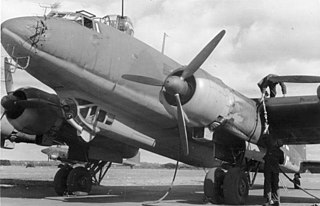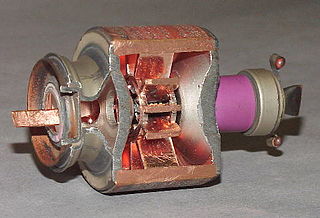This page is based on this
Wikipedia article Text is available under the
CC BY-SA 4.0 license; additional terms may apply.
Images, videos and audio are available under their respective licenses.
German submarine U-862 was a Type IXD2 U-boat of Nazi Germany's Kriegsmarine during World War II. After Germany's surrender in May 1945, U-862 put into Singapore and was taken over by the Imperial Japanese Navy under the name I-502.

German submarine U-234 was a Type XB U-boat of Nazi Germany's Kriegsmarine during World War II. Her first and only mission into enemy or contested territory consisted of the attempted delivery of uranium oxide and German advanced weapons technology to the Empire of Japan. After receiving Admiral Dönitz' order to surface and surrender and of Germany's unconditional surrender, the submarine's crew surrendered to the United States on 14 May 1945.

The Naxos radar warning receiver was a World War II German countermeasure to X band microwave radar produced by a cavity magnetron. Introduced in September 1943, it replaced Metox, which was incapable of detecting centimetric radar. Two versions were widely used, the FuG 350 Naxos Z that allowed night fighters to home in on H2S radars carried by RAF Bomber Command aircraft, and the FuMB 7 Naxos U for U-boats, offering early warning of the approach of RAF Coastal Command patrol aircraft equipped with ASV Mk. III. A later model, Naxos ZR, provided warning of the approach of RAF night fighters equipped with AI Mk. VIII radar.

The Lichtenstein radar was among the earliest airborne radars available to the Luftwaffe in World War II and the first one used exclusively for air interception. Developed by Telefunken, it was available in at least four major revisions, called FuG 202 Lichtenstein B/C, FuG 212 Lichtenstein C-1, FuG 220 Lichtenstein SN-2 and the very rarely used FuG 228 Lichtenstein SN-3.. The Lichtenstein series remained the only widely deployed airborne interception radar used by the Germans on their night fighters during the war — the competing FuG 216 through 218 Neptun mid-VHF band radar systems were meant as a potentially more versatile stop-gap system through 1944, until the microwave-based FuG 240 "Berlin" could be mass-produced; the Berlin system was still being tested when the war ended.

Freya was an early warning radar deployed by Germany during World War II; it was named after the Norse Goddess Freyja. During the war, over a thousand stations were built. A naval version operating on a slightly different wavelength was also developed as the Seetakt.
German submarine U-181 was a Type IXD2 U-boat of Nazi Germany's Kriegsmarine during World War II. The submarine was laid down on 15 March 1941 at the DeSchiMAG AG Weser yard at Bremen as yard number 1021. She was launched on 30 December 1941 and commissioned on 9 May 1942 under the command of Kapitänleutnant Wolfgang Lüth. After training with the 4th U-boat Flotilla at Stettin, U-181 was attached to the 10th flotilla for front-line service on 1 October 1942, then transferred to the 12th flotilla on 1 November.

German submarine U-889 was a Type IXC/40 U-boat of Nazi Germany's Kriegsmarine during World War II.

German submarine U-530 was a Type IXC/40 U-boat of Nazi Germany's Kriegsmarine during World War II. She was laid down at the Deutsche Werft in Hamburg on 8 December 1941 as yard number 345, launched on 28 July 1942 and commissioned on 14 October 1942 with Kapitänleutnant Kurt Lange in command, who led her in six patrols. Lange was replaced in January 1945 by Oberleutnant zur See Otto Wermuth, who led her escape to Argentina after Germany's surrender. The submarine's voyage to Argentina led to many legends, apocryphal stories, and conspiracy theories that together with U-977 it had transported escaping Nazi leaders and/or Nazi gold to South America, or even that it would be involved in the sinking of Brazilian cruiser Bahia as the last act of the Battle of the Atlantic.

The Mid-Atlantic Gap is a geographical term applied to an undefended area beyond the reach of land-based RAF Coastal Command antisubmarine (A/S) aircraft during the Battle of the Atlantic in the Second World War. It is frequently known as The Black Pit, as well as the Atlantic Gap, Air Gap, Greenland Gap, or just "the Gap". This resulted in heavy merchant shipping losses to U-boats. The gap was eventually closed in May 1943, as growing numbers of VLR Liberators and escort carriers became available, and as basing problems were addressed.

German submarine U-73 was a Type VIIB U-boat of Nazi Germany's Kriegsmarine during World War II. She was laid down by Vegesacker Werft, Germany as yard number 1 on 5 November 1939, launched on 27 July 1940 and commissioned on 30 September of the same year under Kapitänleutnant (Kptlt.) Helmut Rosenbaum.
Nachtjagdgeschwader 11 was a Luftwaffe night fighter-wing of World War II. NJG 11 was formed on 20 August 1944 with one Gruppe (group) consisting of 2 Staffeln.
German submarine U-546 was a Type IXC/40 U-boat operated by Nazi Germany's Kriegsmarine during World War II. She was laid down at the Deutsche Werft in Hamburg as yard number 367 on 6 August 1942, launched on 17 March 1943 and commissioned on 2 June 1943 under Oberleutnant zur See Paul Just. The U-boat was a member of three wolfpacks.

The FuG 200 "Hohentwiel" was a low-UHF band frequency maritime patrol radar system of the Luftwaffe in World War II. It was developed by C. Lorenz AG of Berlin starting in 1938 under the code name "Hohentwiel", an extinct volcano in the region of Baden-Württemberg in southern Germany. The device had originally been entered into a design contest held by the Luftwaffe for the new FuMG 40L. When competitor Telefunken won that contract with its "Würzburg radar" in 1939, the device was shelved.
German submarine U-224 was a Type VIIC U-boat of Nazi Germany's Kriegsmarine during World War II.
German Luftwaffe and Navy Kriegsmarine Radar Equipment during World War II, relied on an increasingly diverse array of communications, IFF and RDF equipment for its function. Most of this equipment received the generic prefix FuG, meaning "radio equipment". During the war, Germany renumbered their radars. From using the year of introduction as their number they moved to a different numbering scheme.
German submarine U-876 was a long-range Type IXD2 U-boat built for Nazi Germany's Kriegsmarine during World War II.

The FuMO 21 was designed in 1941 as a search radar for Nazi Germany's Kriegsmarine, suitable for ships between light cruiser and large torpedo boats in size. First designated FMG 39G(gL), it received its final designation when the Kriegsmarine revised its radar nomenclature system around 1943. It was derived from the earlier Seetakt search radar and had an antenna 2 m × 4 m in size.











